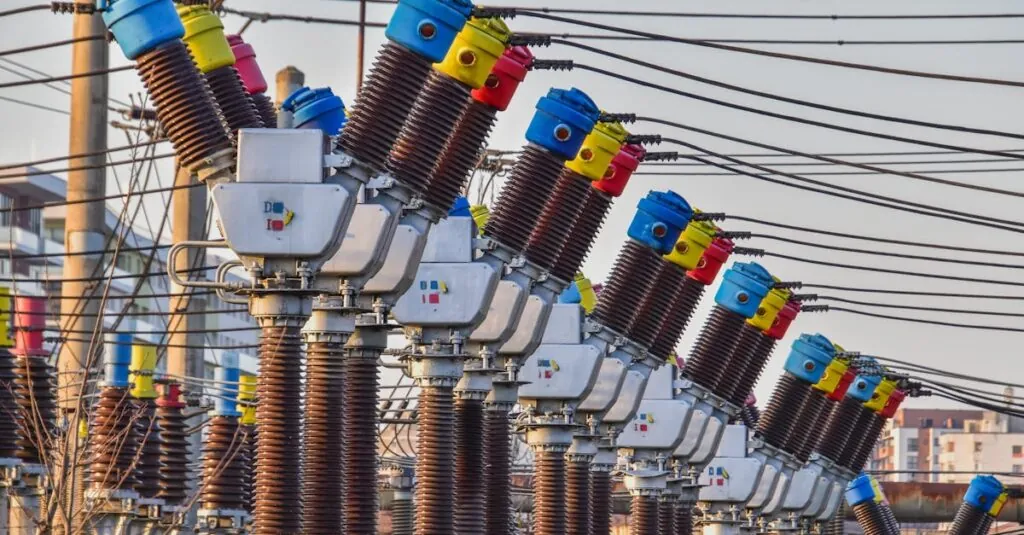In a world where energy bills can feel like a second mortgage, green insulation tech is stepping in like a superhero in a cape—minus the tights. This innovative approach not only keeps homes cozy but also helps save the planet, one eco-friendly material at a time. Who knew that wrapping your house in sustainable goodness could be both smart and stylish?
As homeowners become more eco-conscious, the demand for green insulation solutions is skyrocketing. From recycled materials to natural fibers, these technologies are not just a trend; they’re a revolution. So whether you’re looking to lower your carbon footprint or simply want to stop those pesky drafts, embracing green insulation might just be the best decision since deciding to binge-watch that new series. Dive into the world of sustainable insulation and discover how going green can make your home a fortress of warmth and comfort.
Table of Contents
ToggleOverview of Green Insulation Tech
Green insulation technology utilizes sustainable materials to enhance energy efficiency and reduce carbon footprints. Eco-friendly materials include recycled products, such as denim or cellulose, and natural fibers like sheep’s wool or hemp. Many homeowners prioritize these options due to their thermal performance and minimal environmental impact. This trend integrates effective insulation with stylish aesthetics, appealing to those seeking both functionality and design.
Additionally, various green insulation technologies focus on reducing energy consumption throughout a building’s lifecycle. For instance, spray foam insulation creates an effective air seal, minimizing energy loss. Structural insulated panels (SIPs) offer an alternative by combining insulation and structural support in one efficient product.
Organizations like the U.S. Green Building Council promote green insulation technologies as part of their broader sustainability efforts. Many energy-efficient buildings now pursue certifications such as LEED, highlighting the importance of eco-friendly insulation in achieving these standards. As advancements continue, innovative materials and techniques emerge, further solidifying green insulation’s role in modern construction.
The benefits of green insulation extend beyond energy savings. Improved indoor air quality ranks high among homeowner priorities, as many green materials lack harmful chemicals found in traditional insulations. Real estate values increase when homes incorporate sustainable features, appealing to environmentally conscious buyers.
Adopting green insulation tech not only addresses immediate energy concerns but also contributes significantly to long-term environmental goals. Manufacturers are continually developing products that support sustainability, making green insulation a vital component of eco-friendly construction practices.
Types of Green Insulation Materials
Green insulation materials come in various types, offering eco-friendly solutions to enhance energy efficiency in homes. Each type provides unique advantages and supports sustainability goals.
Natural Fibers
Natural fibers include materials such as sheep’s wool, cotton, and hemp. Sheep’s wool excels in moisture management and thermal performance, creating a comfortable indoor environment. Cotton insulation, often made from recycled denim, is soft, effective, and adds soundproofing benefits. Hemp insulation stands out for its durability and ability to sequester carbon during growth, making it an excellent choice for environmentally conscious homeowners.
Recycled Materials
Recycled materials feature options like cellulose and recycled glass. Cellulose, produced from recycled paper products, delivers excellent thermal performance and fire resistance. Recycled glass insulation offers a non-combustible and moisture-resistant alternative. Both materials divert waste from landfills and contribute to a circular economy, appealing to eco-aware builders and homeowners.
Foam Insulations
Foam insulations consist of closed-cell and open-cell options. Closed-cell spray foam insulation provides superior insulation and acts as a moisture barrier, enhancing building durability. Open-cell foam delivers effective sound dampening while offering lower material costs. Both types reduce energy consumption, aligning with green building principles.
Benefits of Green Insulation Tech
Green insulation technology offers numerous advantages for homeowners and the environment. These materials promote sustainability while enhancing comfort.
Energy Efficiency
Energy efficiency stands out as a primary benefit of green insulation. Materials such as cellulose and denim significantly reduce heat loss and gain, leading to lower energy bills. Spray foam options also create airtight seals that minimize energy waste. Homeowners experience improved thermal regulation, which keeps indoor spaces comfortable year-round. Studies indicate that residences using eco-friendly insulation can achieve energy savings of up to 30%. Overall, these efficiencies contribute to reduced energy consumption and promote cost-effectiveness.
Environmental Impact
Environmental impact plays a crucial role in why green insulation tech gains popularity. Most green materials consist of recycled or renewable resources. For instance, products made from reclaimed cotton or sheep’s wool help divert waste from landfills. Additionally, production processes often consume less energy compared to traditional insulation materials. By choosing green options, homeowners participate in a circular economy that prioritizes sustainability. Data shows that buildings with green insulation contribute to lower greenhouse gas emissions, supporting environmental health.
Health Benefits
Health benefits also accompany the use of green insulation technologies. Many eco-friendly materials promote better indoor air quality by minimizing the presence of VOCs and other harmful substances. Natural fibers, like hemp and wool, absorb moisture, effectively regulating humidity levels. Homes with improved air quality help reduce allergies and respiratory issues for occupants. Enhanced comfort and well-being arise from using non-toxic, breathable materials. Residents often report a more enjoyable living environment when opting for sustainable insulation solutions.
Challenges in Adoption
Adopting green insulation technology presents several obstacles that potential users face.
Cost Considerations
Initial investments for green insulation materials can be higher compared to traditional options. For example, eco-friendly products like sheep’s wool or denim may carry a premium price tag. Long-term savings on energy bills help offset these initial costs, yet many homeowners remain hesitant to invest upfront. Financing options exist, but limited awareness of these alternatives can hinder adoption. Many people weigh short-term budgets against long-term benefits, leading to reluctance in making the switch.
Availability and Accessibility
Finding sustainable insulation materials can pose a challenge in certain markets. Not all regions offer a wide range of eco-friendly options, limiting choices for homeowners and builders. Suppliers who specialize in green building materials tend to be concentrated in urban areas, which complicates access for residents in rural regions. Additionally, many contractors lack experience with these materials, resulting in a gap in knowledge that affects installation quality. As availability improves, awareness will grow, encouraging wider adoption of green insulation options.
Future Trends in Green Insulation Tech
Emerging trends in green insulation technology focus heavily on bio-based materials. Innovations in cellulose and hemp show promising thermal properties while being sustainable. Manufacturers increasingly prioritize materials derived from agricultural waste, reinforcing a circular economy.
Additionally, advancements in insulation performance enhance energy efficiency. Research continues to unveil new composites that enhance thermal resistance without adding significant weight. Spray foam insulation also evolves, with formulations improving indoor air quality due to low volatile organic compound (VOC) emissions.
Smart technology integration within insulation systems transforms energy management. Sensors enable real-time monitoring of temperature and humidity, allowing homeowners to adjust HVAC systems efficiently. This technology helps reduce energy waste and promotes smarter energy consumption.
Furthermore, the trend toward prefabricated insulation solutions gains traction. Prefabricated panels reduce construction time and waste, streamlining the building process. They often come with pre-applied insulation, ensuring consistent quality and performance.
In urban environments, growing interest in green roofs and wall systems becomes evident. These systems provide additional insulation while contributing to biodiversity and improved air quality. Homeowners increasingly recognize the dual benefits of aesthetic and environmental enhancement.
Collaborations between contractors, manufacturers, and green building organizations strengthen education and accessibility. More training programs emerge, equipping contractors with the knowledge to install advanced green insulation. Such initiatives lead to improved adoption rates across various markets.
Overall, these trends indicate a shift toward greater sustainability and efficiency in building practices. As awareness and technology improve, green insulation will remain a vital component in the quest for energy-efficient and eco-friendly homes.
Conclusion
The shift towards green insulation technology marks a significant step in enhancing energy efficiency and promoting sustainability. Homeowners are increasingly recognizing the value of eco-friendly materials that not only lower energy costs but also contribute to healthier living environments. As innovative solutions and sustainable practices continue to evolve, the adoption of these technologies is expected to rise.
With a focus on reducing environmental impact and improving indoor air quality, green insulation stands out as a practical choice for modern homes. The future looks promising as more contractors and manufacturers embrace these advancements, making green insulation accessible to a wider audience. This trend not only supports individual homeowners but also aligns with broader efforts to create a more sustainable and energy-efficient world.




